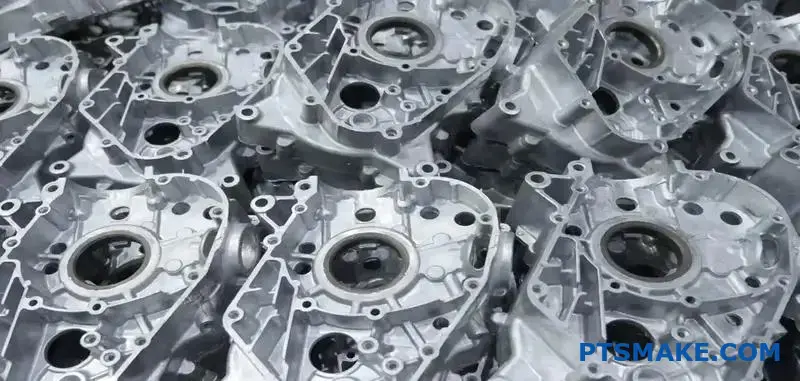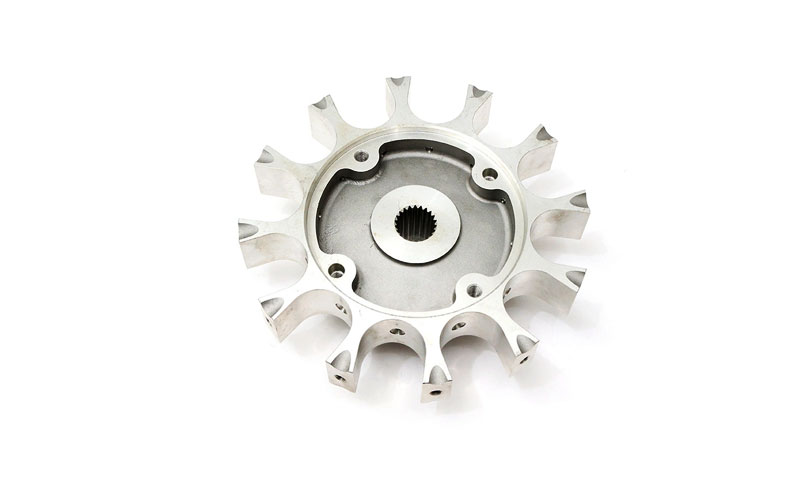Best Practices to Reduce Defects in Precision aluminum casting
Wiki Article
Aluminum Casting Explained: Trick Realities and Insights for Sector Professionals
Aluminum casting serves as a crucial procedure in modern manufacturing, shaping components across different fields. Its varied methods, such as sand and die casting, cater to various manufacturing demands. The distinct residential properties of aluminum alloys boost their applicability, yet tests remain in keeping top quality and effectiveness. Recognizing these facets is necessary for market professionals. What are the most recent improvements and finest practices that can further maximize this procedure?Summary of Aluminum Casting Processes

Crucial element of aluminum casting procedures consist of the preparation of molds, which may be made from sand, metal, or ceramic products, depending on the intended usage. Additionally, temperature control is essential to assure appropriate melting and solidification of aluminum.
The casting process enables complex layouts and can accomplish high degrees of dimensional precision. Once cooled down, the spreadings may undergo completing procedures such as machining or surface therapy to fulfill particular performance standards. On the whole, aluminum casting functions as a flexible manufacturing technique, successfully satisfying the diverse requirements of numerous industries.
Sorts Of Aluminum Casting Approaches
In the domain name of aluminum casting, numerous techniques are used to accomplish various outcomes. Sand casting methods give versatility and cost-effectiveness for complex forms, while die casting processes supply high precision and effectiveness for automation. Recognizing these techniques is crucial for picking the proper strategy based on task needs.Sand Casting Methods
Sand casting methods stand for a basic approach in aluminum casting, where sand is used as a mold material to shape molten steel. This process includes creating a pattern from the preferred component, which is then positioned in a sand mix to create a mold. The sand is compressed around the pattern, and after elimination, it develops a dental caries in the shape of the part. Molten aluminum is poured right into this cavity, allowing it to strengthen and cool. One substantial benefit of sand casting is its versatility; it can suit intricate forms and large parts. Furthermore, the materials made use of are fairly low-cost, making it an obtainable alternative for different manufacturing applications in the aluminum sector.Die Casting Processes
Die casting processes are a famous technique for shaping aluminum parts, making use of high-pressure methods to force molten metal right into precisely engineered molds. This process is particularly favored for its capability to produce intricate forms with tight resistances and a smooth coating. There are two primary types of die casting: warm chamber and cool chamber. Warm chamber die casting appropriates for metals with low melting points, permitting faster production rates. On the other hand, chilly chamber die casting is excellent for higher melting factor metals, requiring a different melting heater. Both approaches enhance performance and decrease material waste, making them necessary in auto, aerospace, and customer goods markets. Recognizing these processes helps professionals select the most ideal technique for their details applications.Material Residence of Aluminum Alloys

Strength and Sturdiness
Toughness and resilience are crucial qualities of aluminum alloys that make them suitable for different casting applications. These materials exhibit a positive strength-to-weight proportion, enabling the creation of lightweight yet durable elements. When it come to tensile toughness, certain aluminum alloys can be engineered to hold up against substantial loads without deforming. This building is specifically vital in markets such as aerospace and auto, where performance and safety and security are vital. In addition, aluminum alloys often retain their mechanical properties under diverse temperature problems, guaranteeing consistent efficiency. The intrinsic ductility of these alloys additionally enables effective shaping during the casting procedure, making it easier to produce intricate geometries. On the whole, the strength and sturdiness of aluminum alloys contribute considerably to their extensive usage in innovative applications.Corrosion Resistance Characteristics
While aluminum alloys are valued for their toughness and lightweight homes, their deterioration resistance is another vital feature that boosts their suitability for numerous applications. Aluminum normally develops a protective oxide layer when exposed to dampness, which aids to protect against more oxidation. This inherent building makes aluminum alloys specifically important in settings susceptible to rust, such as industrial and marine settings. Additionally, different alloy make-ups can influence resistance levels, with certain alloys especially engineered to enhance this particular. Treatments like anodizing can even more enhance rust resistance by thickening the oxide layer. Consequently, understanding the deterioration resistance of aluminum alloys is crucial for industry experts when choosing products for jobs calling for resilience and blog here longevity in tough atmospheres.Home Page
Advantages of Aluminum Casting in Production
Aluminum casting offers numerous advantages in manufacturing, making it a recommended option for various markets. One significant benefit is its lightweight nature, which adds to lowered transportation prices and boosted power effectiveness in final product. Aluminum's superb thermal and electric conductivity enhances functionality in applications requiring warmth dissipation or electrical conduction.The material's ability to be cast into complex forms enables design versatility, reducing the demand for extra machining procedures. On top of that, aluminum casting shows remarkable rust resistance, bring about longer product life-spans and lower upkeep costs.

Typical Applications of Aluminum Castings
The adaptability of aluminum casting enables its prevalent use throughout different markets. Common applications include automotive parts, where lightweight and corrosion-resistant components, such as engine blocks and transmission real estates, boost car performance. In the aerospace field, aluminum spreadings are used for architectural components, providing stamina without including significant weight.
Furthermore, the electrical market gain from aluminum spreadings in manufacturing enclosures and warmth sinks, where thermal conductivity is essential. The consumer products market also integrates aluminum castings in items like cooking equipment, furniture, and ornamental products, incorporating looks with capability.
The building sector uses aluminum spreadings for architectural aspects, home window structures, and components, which give toughness and design adaptability. In general, the diverse applications of aluminum spreadings emphasize their value in modern-day manufacturing, adding to improvements in efficiency and item layout across multiple fields.
Advancements and Technical Improvements
As industries remain to progress, technologies in aluminum my site casting innovation are transforming manufacturing procedures and item capacities. Improvements in 3D printing and additive production have actually allowed the creation of complex geometries that were formerly impossible to accomplish with conventional techniques. These innovations permit rapid prototyping, minimizing lead times and expenses.Additionally, enhancements in mold design and products have actually improved the casting process by raising performance and decreasing waste. The combination of wise production methods, such as IoT gadgets and real-time data analytics, permits much better tracking and optimization of manufacturing criteria, causing better outputs.
Growths in aluminum alloys give improved stamina, rust resistance, and lightweight residential properties, catering to the growing demands in automotive and aerospace markets. Collectively, these technologies are not just enhancing efficiency but likewise satisfying the extensive standards of modern-day design applications.
Ideal Practices for Quality Control in Aluminum Casting
Making sure top quality outputs in aluminum casting calls for adherence to best methods that incorporate different stages of the production procedure. First, thorough material assessment is necessary to confirm the quality of aluminum alloys used, as pollutants can greatly impact the final item. Executing specific melting and pouring methods minimizes problems; maintaining suitable temperatures prevents oxidation and advertises uniformity.Mold and mildew style plays a critical function; using computer-aided style (CAD) can improve accuracy and reduce human error. Routine monitoring of the cooling procedure is essential to stay clear of warping and shrinkage. Additionally, making use of non-destructive screening methods, such as ultrasonic or X-ray assessments, aids recognize inner flaws without harming the parts.
Ultimately, developing a feedback loop with drivers and engineers fosters continuous enhancement, making certain that quality assurance procedures develop alongside technological innovations. By following these finest methods, suppliers can improve the reliability and efficiency of aluminum castings.
Frequently Asked Questions
What Are the Environmental Influences of Aluminum Casting?
The ecological impacts of aluminum casting consist of significant energy usage, greenhouse gas discharges, and prospective water air pollution from foundry operations. In addition, bauxite mining for aluminum ore can result in habitat damage and soil degradation.How Does Aluminum Casting Contrast to Other Metal Casting Processes?
Aluminum casting typically supplies benefits in light-weight elements and corrosion resistance compared to various other processes, such as iron or steel casting, which might provide better strength however cause heavier and much less corrosion-resistant items. - aluminum castingWhat Are Common Defects in Aluminum Castings and Their Reasons?
Typical issues in aluminum castings consist of porosity, contraction, and incorporations. Causes typically come from improper putting strategies, insufficient mold and mildew design, or contamination of the liquified steel, affecting the end product's stability and performance.What Safety Precautions Should Be Taken Throughout Aluminum Casting?
Throughout aluminum casting, necessary security precautions consist of using protective equipment, guaranteeing proper air flow, preserving a tidy office, dealing with liquified metal with treatment, and following established procedures to reduce threats of burns, breathing dangers, and accidents.Just How Can I Boost the Effectiveness of My Aluminum Casting Workflow?
To improve performance in aluminum casting operations, one should maximize mold design, simplify material handling, use automated processes, perform routine upkeep on devices, and buy worker training to boost skills and efficiency.Numerous techniques exist, aluminum casting incorporates several main procedures that cater to different applications and needs. Key aspects of aluminum casting procedures include the preparation of mold and mildews, which might be made from sand, metal, or ceramic products, depending on the planned usage. Sand casting strategies represent a basic technique in aluminum casting, where sand is made use of as a mold product to form liquified steel. As markets proceed to evolve, technologies in aluminum casting innovation are changing manufacturing procedures and item capabilities. Making sure high-quality outputs in aluminum casting requires adherence to finest practices that incorporate numerous stages of the production process.
Report this wiki page